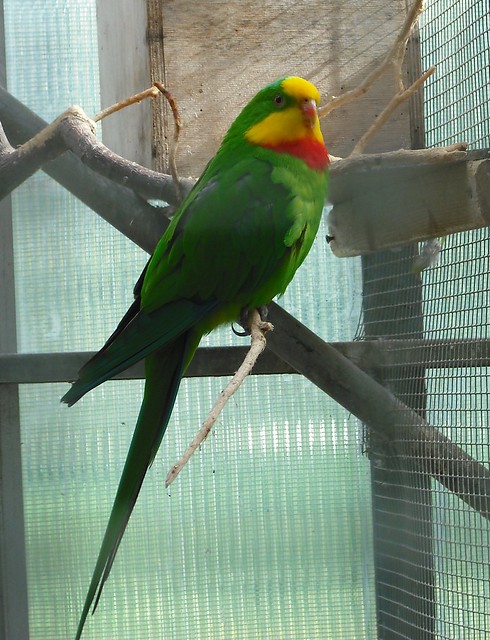The 1964 musical "My Fair Lady" features a song entitled "Wouldn't It Be Loverly?" with music by Frederick Loewe, lyrics by Alan Jay Lerner. In that song, Eliza sings: "All I want is a room somewhere, Far away from the cold night air, With one enormous chair. Oh, wouldn't it be loverly?"
Parrots, were they able to verbalize, might sing a similar tune: "All I want is a cage somewhere, Strong and spacious, but not too bare, With tender, loving care. Oh, wouldn't it be loverly?"
 |
| Photo by Vicburton |
Parrot Cages
Just as parrots come in many sizes, parrot cages vary from small to large. They come in rectangles and cylinders, plain and fancy. Parrot cages can be difficult to purchase, and the savvy buyer will do research before attempting to do so. Four of the factors to be considered are given here, but you will want to discuss your final purchase with a knowledgeable dealer.
1. Parrot Breed and Size
The breed and size of your parrot figure strongly in the consideration of available parrot cages.
Large birds need sufficient space to stretch big wings, climb around, and enjoy healthy exercise. Large parrot cages are needed for parrots in the size range of African Grey Parrots, Amazons, Cockatoos, and Macaws. Large parrot cages should be made of steel or metal, and have a bar spacing of one or more inches. Any smaller spacing in large parrot cages will permit your parrot to get caught and injure itself.
Medium parrot cages are good for medium size parrots such as Caiques, Cockatiels, Conures, and Senegals. Medium parrot cages should have steel or metal bars spaced 1/2 to 5/8 inch apart. Parrot cages with larger or smaller bar spacing may allow your bird to be injured.
If you have a small parrot such as a Budgerigar (Budgie), Lovebird, or Parrotlet, you will need to look at small parrot cages. Small parrot cages also should be of steel or metal, since all parrots love to chew. Bar spacing should be 1/2 inch or less in small parrot cages.
2. Configuration
The configuration of parrot cages is the size and shape. Since parrots like to climb and fly, parrot cages need to be tall. Even the most basic, small parrot cages should be at least 7-8 inches taller than their width and depth. Dome tops are functional as well as attractive in parrot cages. The parrot will amuse itself climbing across the dome. Wide cages are important for larger parrots, as they will need to fly back and forth. While some parrot cages are built to resemble castles or Victorian homes, complete with turrets, one must be sure the décor does not involve sharp edges or small corners where a parrot can injure feet or beak.
3. Accessories
Accessories can go a long way toward making parrot cages "lovely" in the parrot's thinking. Stands raise parrot cages to a higher level, allowing the bird to see more, and feel more a part of the "flock" in your home. Stands also give owners better access to their parrots. For parrots that crave more attention, parrot cages on wheeled stands can be moved from room to room.
Parrot cages can also be topped with exercise areas, providing entertainment and exercise when the parrot is out for play. Swings, ladders, toys, steps, and more can be included in playgrounds.
The feeder cups in parrot cages should be easily accessible and should be made of steel, ceramic, or reinforced plastic. Parrots will chew on the cups as part of their exercise, and can readily destroy other materials.
Parrot cages require at least three different perches, each made of a different material. Rope, hardwood, and cement are three possibilities. Proper perches are important to the health of your parrot's feet.
Cage covers are important additions to parrot cages, allowing your bird to get the right dark and light cycle to get sufficient rest.
4. Toys
Finally, all parrot cages will need convenient places to attach toys - and entertaining toys to be attached. Like parrot cages, parrot toys come in different sizes and materials to suit the breed of parrot. Parrot toys do not have to be elaborate. Toys may entertain and may stimulate your bird intellectually, but their main purpose is to help parrots use the actions they would use in the wild. Toys help them "hunt" food, hide in the "leaves" of a tree, and exercise their beaks to keep them strong.
Toys in parrot cages can be for their feet, giving them foot exercise that helps them maintain dexterity. Toys may be filled with food that parrots must retrieve, chewing away obstacles as they would in the wild. Small mirrors in parrot cages allow the birds to converse with "friends" in the same tree.
Learn as much as you can about your parrot breed, and ask for appropriate toys that will meet the bird's varied needs.
Conclusion: Parrot cages are a big investment. Be sure you shop carefully.
By Anna Hart - (C) 2007, An avid reader and researcher, Anna explores many parrot breeds and offers more information about parrots and their care at http://www.parrots-of-the-world.com If you are interested in learning more about perches for parrot cages, you won't want to miss the information Anna shares on her website.
Article Source: EzineArticles
|

No comments:
Post a Comment